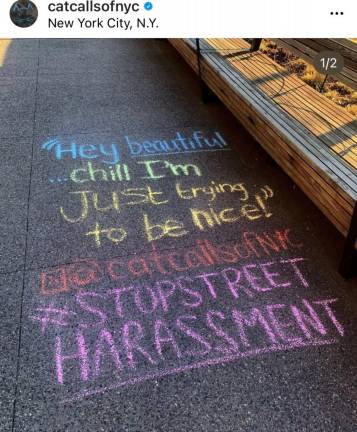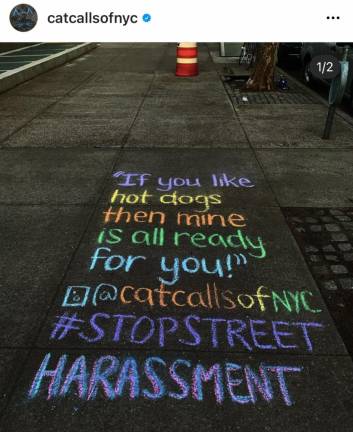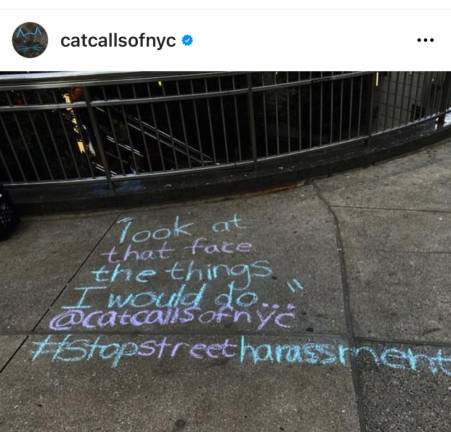Catcalls of NYC: Fighting Street Harassment
An Instagram account created by a New Yorker as a school project now reaches 150 cities worldwide



At 19, Sophie Sandberg created a school project that mapped out her experiences with street harassment in New York, where she grew up. In less than seven years, a youth-led movement has reached over 150 cities worldwide and has sparked conversation and change with thousands of followers and volunteers globally.
“I usually describe Catcalls of NYC as an Instagram account, an initiative that uses chalk art to fight street harassment ... What all the volunteers within Catcalls of NYC do is collect people’s stories of street harassment. We solicit stories via Instagram DM, occasionally also now on TikTok, or even word of mouth,” said Sandberg. “Then we actually go to the locations where people are experiencing street harassment and write down the word-for-word phrases of the harassment on the street with chalk alongside the hashtag #StopStreetHarassment. Then we post it back to Instagram or TikTok.”
The Catcalls of NYC Instagram account immediately caught global attention. As other cities around the world felt inspired to create their own “Catcalls of...” accounts, the collective name for the initiative became Chalk Back.
“Late 2017, early 2018 is when it started spreading globally... I was beyond excited ... that people were using this idea that I thought of for a school project. So, it started small,” said Sandberg, who is now recognized globally for her activism. “It was really exciting to see that it was having a global impact and that it was resonating with people. To this day, it’s still really exciting to see new people joining and also the different accounts around the world are growing so much.”
Sparking Conversation Globally
While Catcalls of NYC has 170,000 followers, Catcalls of Cairo, Egypt has 29,000, and Catcalls of Hanover, Germany has 18,000.
“It’s really amazing to see how each page built their own community and their own following and gets a ton of press attention. I’m so proud of all of the different accounts that have popped up over the years,” said Sandberg.
Despite sparking conversation globally, Sandberg’s work is focused on the local impact in each city. Each account creates an essential dialogue with both those who have experienced harassment and those who initiate it. Her experiences growing up in New York have driven her work and her demand for change.
Another essential outcome has been dialogue with those who have not faced street harassment, but due to the account now wish to intervene if they witness harassment or support the movement as allies. Sharing resources on this scale ensures a way to make public spaces a bit safer.
“The most rewarding are the conversations with young people. Particularly, girls and young women, who are starting to experience street harassment, and are feeling isolated and confused. Then they find the project and [say] ‘oh, wow, there’s this whole community here. Thank you so much for what you’re doing. This is really powerful,’” said Sandberg. “I grew up in New York, and I was getting catcalled as a teenager, and I didn’t have something like this.”
“It’s really cool seeing people as young as middle school and high school starting to have these conversations,” Sandberg said, “I feel like that actually has a big impact on the culture, because if people are talking about it that young, it’s going to start to shift how people understand street harassment and catcalling and flirting and gender norms.”
Map of Catcalls
This approach to combatting harassment came to mind when Sandberg was thinking of mapping her experiences for an undergraduate assignment. She decided to map out places where she was catcalled, inspiring much of her work today.
“I still so vividly remember when I was 15, I had this summer job, and I would have to walk down these long blocks on 14th Street. I cannot think about those blocks without thinking about the catcalls and my first catcalling experiences ... I think it’s really common to have memories tied to certain places when you’re experiencing something like catcalling or street harassment.”
It was essential to Sandberg that the catcalls were written in chalk exactly where the harassment occurred. To Sandberg, “it’s a really powerful thing to be able to say, this happened right here, where I’m writing it, and you don’t want to pay attention to me writing it. It’s already happening right here.” It neglects the notion that harassment isn’t pervasive in every space.
Often, harassment is normalized and overlooked. Yet in bright hues, it is impossible to ignore the incident and catches the eye of most that pass by, demanding acknowledgment. However, not all are open to conversations surrounding the chalk. While some try to erase it, others perceive it as an introduction to vulgarity to innocent children.
Sandberg experienced harassment even while chalking others’ stories of harassment.
“Something that surprised me at first that was ironic was that... I would get harassed and crept on by these older men on the street as I was chalking. They would often take it as an invitation,” said Sandberg. “In some ways [it was] not surprising because that’s the point of the whole project... it was just an interesting layer to have to encounter that.”
While many New Yorkers experience street harassment, there are different factors within and beyond gender-based harassment that people experience.
“All of the harassment that we’re talking about primarily is gender-based harassment, and then it becomes super layered. People can be impacted by harassment because of other parts of their identity,” Sandberg said, “race, ethnicity, religion, ability, gender identity, sexuality, all of these factors really come into play in ways that I’ve seen with a lot of firsthand stories that people submit ... There are so many layers to people’s different identities, and that all impacts how everyone experiences harassment.”
“I grew up in New York, and I was getting catcalled as a teenager, and I didn’t have something like this.” Sophie Sandberg, creator of Catcalls of NYC